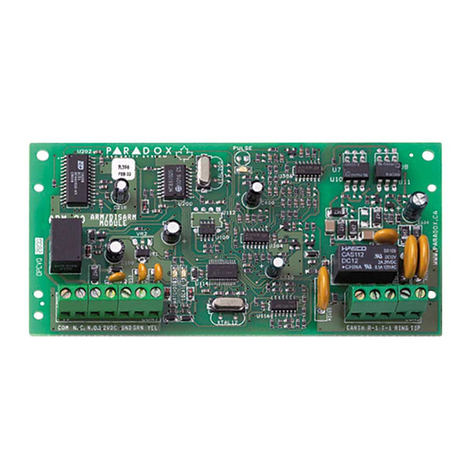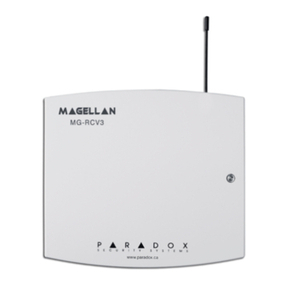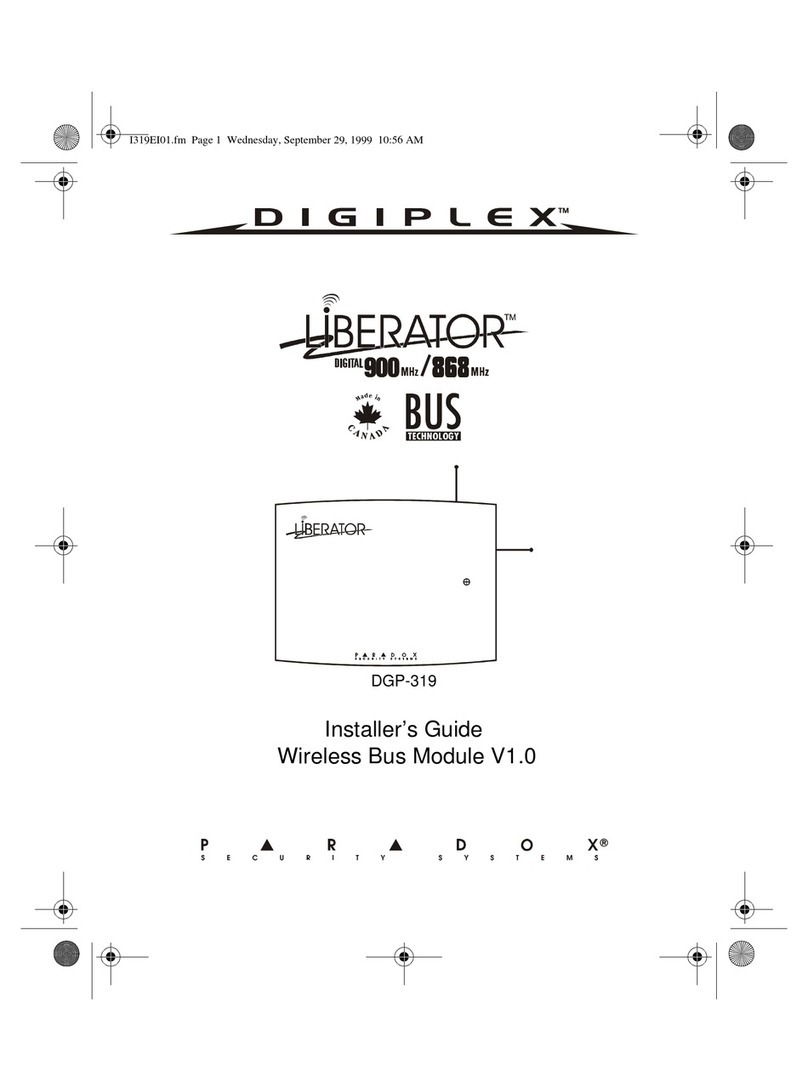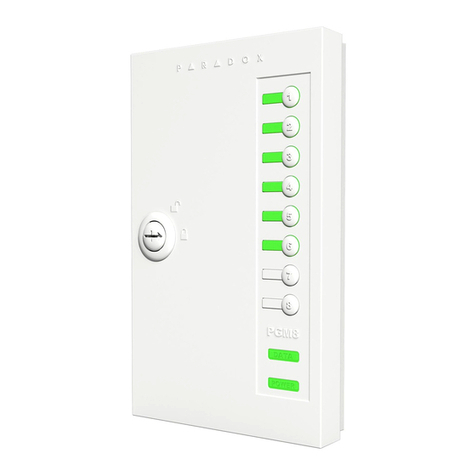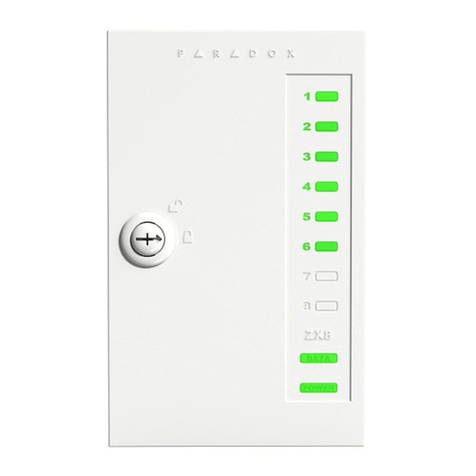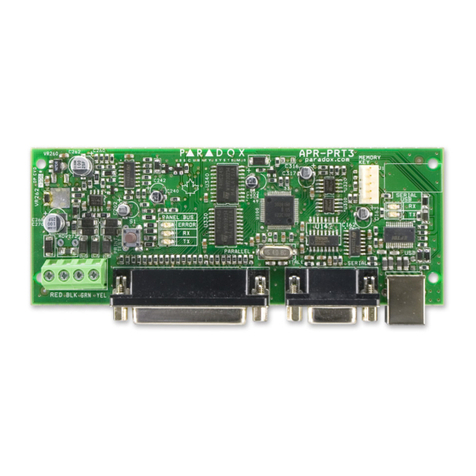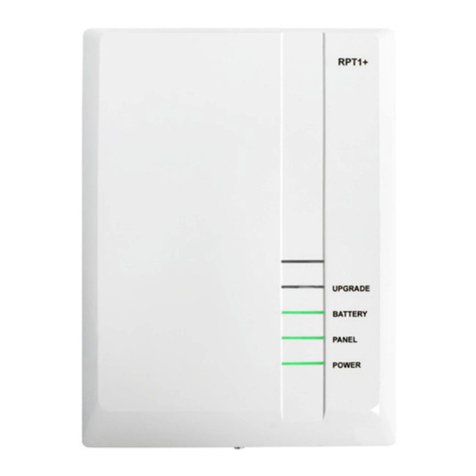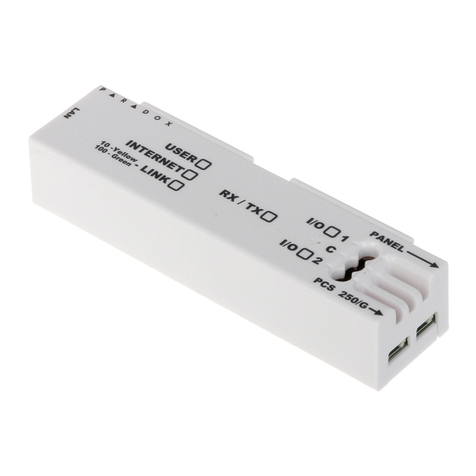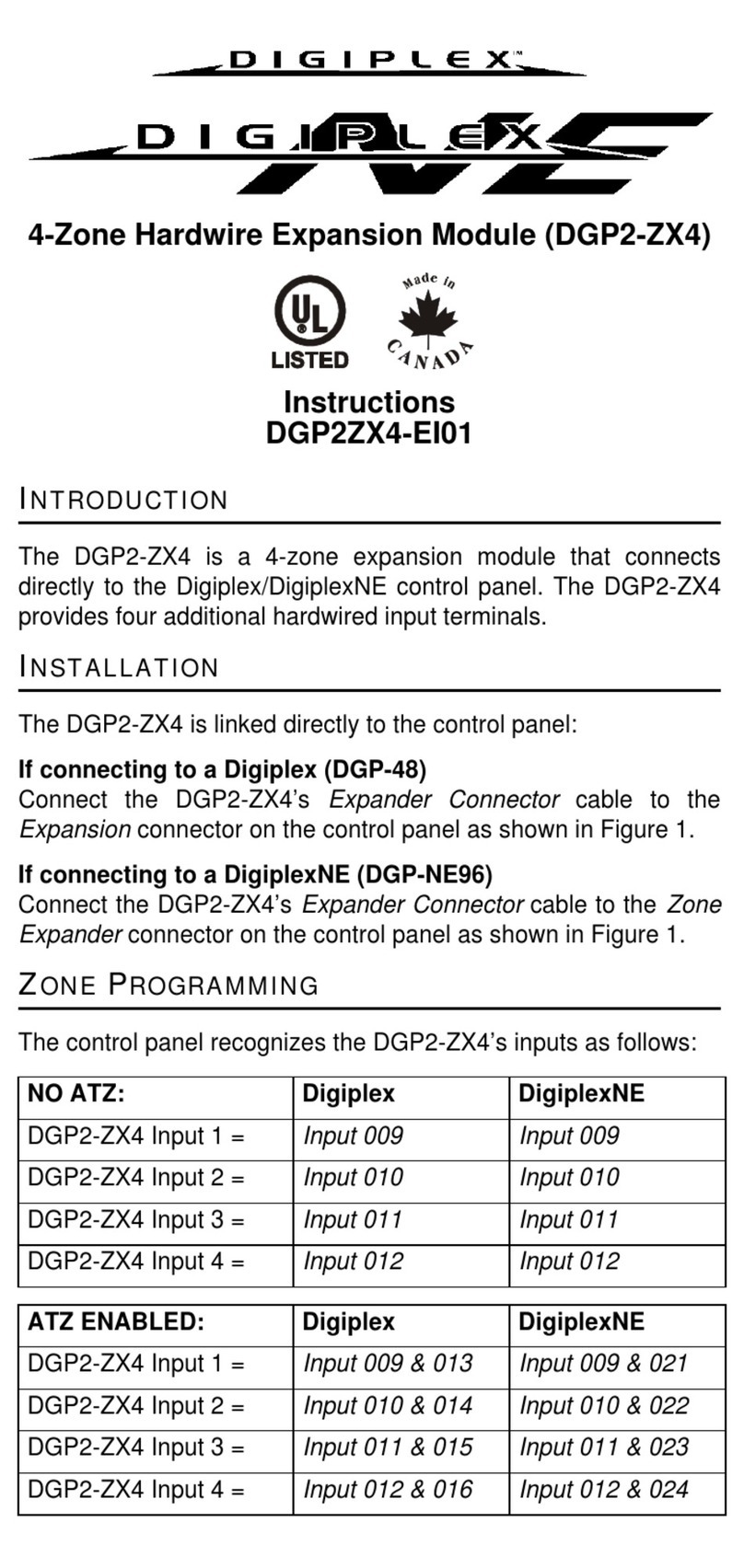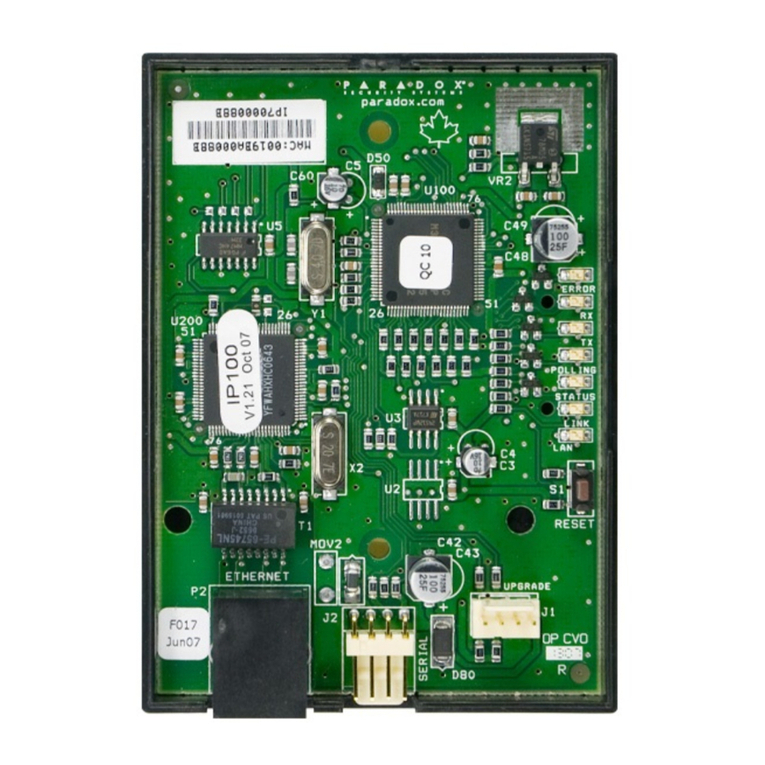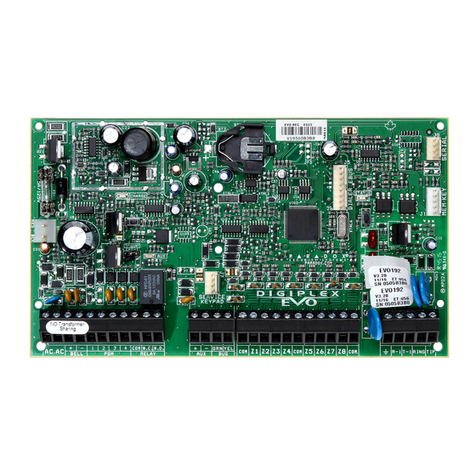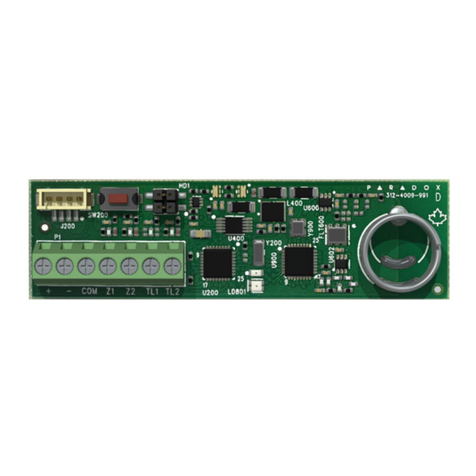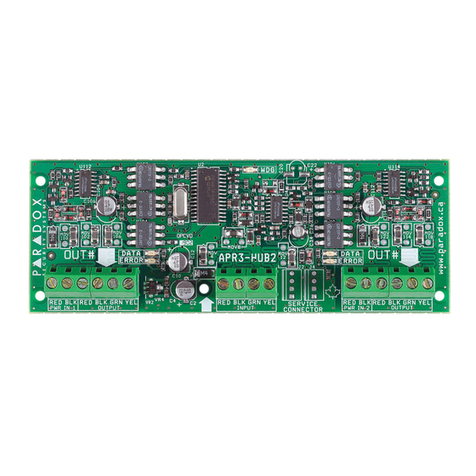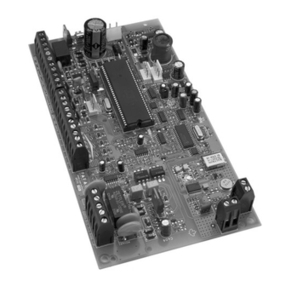
What’s New with Version 1.4
• Added support for the REM3 Hand-Held 2-Way Remote Keypad
(compatible with RTX3 V1.31 and higher)
• Added flexible PGM deactivation option (see Table 2)
Introduction
The RTX3 (previously MG-RTX3) is a 2-Way Wireless Expansion Module
for use with any Digiplex EVO, Spectra SP, and Esprit series control panel.
It is also compatible with the DGP-NE96 and DGP-848 control panels.
Compatibility
Before Programming
1. Connect the RTX3 according to the installation guide.
2. Write down the serial number of all wireless modules to be used with
the RTX3. If this installation replaces another RTX3, ensure the
programming can be transferred.
3. Ensure every wireless module works properly and that you have the
latest version of the firmware for the RTX3 and panels.
System Reset
Press and hold the Programming button for 5 seconds, the BUS RX LED
flashes. Release the button and press it again while the LED flashes to
reset the module to its default values. The system reset feature only
functions during the first 30 seconds after the RTX3 is powered up.
Hardware EVO Spectra SP Esprit Stand-Alone
Zones: 32 32 - 32
Remotes: 32/96/999 32 32 32
Wireless PGMs: 8 16 - -
Wireless Keypads: - 8 - -
2-Way Remote: 33 --
Wireless Repeater: - 2 - -
PX8: - - - 4
Software
WinLoad: (V4.5 or higher)
PARADOX.COM
Printed in Canada 06/2008
Wireless Expansion Module
RTX3 V1.4
Instructions
Programming with Spectra SP Series
When connected to a Spectra SP series panel, the RTX3 settings are programmed into the panel. Refer to the panel’s
Programming Guide. Requires version 2.0 or higher of the K32 or K10H/V keypads. Only one RTX3 can be connected to
a Spectra SP Series panel.
Programming with Digiplex EVO
To enter programming mode with a Digiplex EVO panel:
1. Press and hold the [0] button. Enter the installer code and go to section [4003].
2. Enter the RTX3’s 8-digit serial number.
3. Enter the section number you wish to program.
After Programming with EVO
Program the zones, PGMs, and remotes into the EVO panel. For wireless transmitter supervision options, refer to EVO
section [3034] and RTX3 section [001] options [2] and [3].
* The new visual and auditory feedback includes the following system statuses: stay armed, instant armed and exit delay. Other status
feedback has not changed. Note that for REM2 versions 1.04 or older, stay arm, instant arm and exit delay statuses are not supported, and
a rejection beep will be heard when the system is in these statuses.
Table 1: Digiplex EVO Programming
Section Feature
[001]
RTX3 Options
Option [1]: Low battery supervision (default: ON)
Option [2]: Check-in supervision (default: OFF)
Option [3]: Check-in supervision time interval
OFF = 24 hours (default)
ON = 80 minutes
Option [4]: RF jamming supervision (default: ON)
Option [5]: On-board module tamper supervision (default: OFF)
Option [6]: PGM1 Initial State
OFF = Normally open (default)
ON = Normally closed
Option [7]: PGM2 Initial State
OFF = Normally open (default)
ON = Normally closed
Option [8]: Ignore transmitter tamper signal
OFF = RTX3 ignores tamper signal (default)
ON = RTX3 reports tamper signal
Remote Control Programming
With EVO641/EVO641R keypad: Program 999 remotes with one RTX3 (refer to User Code and Remote
Control programming in the Digiplex EVO Programming Guide).
Without EVO641/EVO641R keypad: Program 32 remotes per RTX3 as detailed in Table 3.
[002]
Remote Control Options
Option [1]: MG-REM2 Visual and auditory feedback compatibility options*
OFF = Old visual and auditory feedback. (Supported by MG-REM2 V2.00 or higher)
ON = New visual and auditory feedback. (MG-REM2 V2.01 or higher with EVO641 /
EVO641R keypads.) (Default)
[030] View Transmitter, Remote and PGM Serial Numbers
To view a transmitter’s 6-digit serial number, press and hold the transmitter’s anti-tamper switch or press
any remote control button.
[101] to [132] Assign Wireless Transmitters
[101] = Zone Input 1; [132] = Zone Input 32
Enter 6-digit serial number or press and release the transmitter’s tamper switch.
To delete an assigned transmitter, enter 000000 as a serial number.
[601] to [632] Transmitter Signal Strength
[601] = Zone Input 1; [632] = Zone Input 32
3 or less = weak (move transmitter); 4 to 10 = OK.
[701] to [732] Current Battery Life
[701] = Zone Input 1; [732] = Zone Input 32
View number of weeks the batteries have been in the transmitter.
[801] to [832] Previous Battery Life
[801] = Zone Input 1; [832] = Zone Input 32
View number of weeks the previous batteries were in the transmitter.
[671] to [678] Two-Way PGM Signal Strength
[671] = PGM 1; [678] = PGM 8
3 or less = weak (move transmitter); 4 to 10 = OK.
[901] to [908]
Assign Two-Way PGMs
[901] = PGM 1; [908] = PGM 8
Enter 6-digit serial number or press and release the transmitter’s tamper switch
To delete an assigned Two-Way PGM, enter 000000 as a serial number.
If a section between [901] to [904] is empty, the RTX3 will use the on-board PGM.
[910] to [989] PGM Programming
Program the Two-Way PGM activation event, deactivation event and PGM Delay options. Refer to
Table 2.
[991] View Two-Way PGM tamper trouble (PGM # in trouble will be displayed)
[992] View Two-Way PGM supervision trouble (PGM # in trouble will be displayed)
WARNING: When used without an EVO641 or EVO641R keypad, enable EVO option [1] in section [3029].
Table 2: Digiplex EVO PGM Programming
PGM Activation* PGM Deactivation* PGM Delay
Event
Group Feature
Group Start # End # Event
Group Feature
Group Start # End Delay
(000 to
255) Options
PGM1 [910] [911] [912] [913] [914] [915] [916] [917] [918] [919]
PGM2 [920] [921] [922] [923] [924] [925] [926] [927] [928] [929]
PGM3 [930] [931] [932] [933] [934] [935] [936] [937] [938] [939]
PGM4 [940] [941] [942] [943] [944] [945] [946] [947] [948] [949]
PGM5 [950] [951] [952] [953] [954] [955] [956] [957] [958] [959]
PGM6 [960] [961] [962] [963] [964] [965] [966] [967] [968] [969]
PGM7 [970] [971] [972] [973] [974] [975] [976] [977] [978] [979]
PGM8 [980] [981] [982] [983] [984] [985] [986] [987] [988] [989]
Default Data 000 000 000 000 000 000 000 000 005 OFF
The following options apply to sections [919],[929]... [989]:
Option [1]: PGM deactivation after:
See table on right
Option [2]: PGM base time:
ON = Minutes OFF = Seconds (default)
Option [8]: Flexible PGM deactivation**:
See table on right
* For a complete list of events,
refer to the PGM programming
section of your Digiplex or
Digiplex EVO control panel’s
Programming Guide.
** In order to use the “Flexible
PGM deactivation” option (option
[8]), the PGM deactivation after
option (option [1]) must be ON.
Table 3: Programming without an EVO641/EVO641R
[040] to [043] View or Delete Used Remotes
[040] = remotes 1 to 8; [043] = remotes 25 to 32.
To delete a remote, press the corresponding number until it is no longer displayed in these sections.
[201] to [232] Assigning Remote Controls to the System
[201] = remote 01; [232] = remote 32
Enter the desired section and then press and hold a button on the remote control until you hear a
confirmation beep.
[301] to [332] Assign Remotes Controls to Users
Assign the remote controls to users by entering a user number (001 to 255) in the appropriate section
(Users 001 to 255, Section [301] = remote 01, section [332] = remote 32.)
[401] to [432]
Program or Delete Remote Control Button Configuration
[401] = remote 01; [432] = remote 32
______/ ______/ ______/ ______/ ______/ ______/ ______/ ______ (default: 15000000)
see Figure 1
see Figure 2
[0] = Button Disabled [8] = Panic 2 (Auxiliary or Medical)
[1] = Regular Arm [9] = Panic 3 (Fire)
[2] = Stay Arm [STAY] = Smoke reset
[3] = Instant Arm [FORCE] = Utility Key 1
[4] = Force Arm [ARM] = Utility Key 2
[5] = Disarm [DISARM] = Utility Key 3
[6] = Stay/Instant Disarm [BYP] = Utility Key 4
[7] = Panic 1 (Police) [MEM] = Utility Key 5
[CLEAR] = Exit without saving [ENTER] = Save data
[1] [8]
OFF OFF Deactivation Event
OFF ON Deactivation Event
ON OFF PGM Timer
ON ON PGM Timer or
Deactivation Event
Figure 1: REM1 Figure 2: REM2
RTX3-EI05
